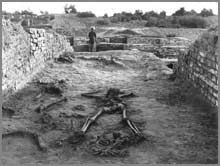Truth Values
 The use of archaeology to build up truth-values of notions derived from elsewhere is explicit in the ‘Aryan’ and ‘non-Aryan’ racial classifications that were imposed on the archaeological finds. The two categories into which the ‘races of India’ were variously placed, and which were touted as historical truths from the middle of the nineteenth century, allowed Fergusson to claim that “India is now, and always has been, inhabited by two distinct and separate races; the one, aboriginal, as far as we know- inhabiting the whole of southern part of the peninsula, and speaking languages of which Tamil is the principal and most typical, but all having a great affinity to one another, and no trace of relationship to the Sanskrit. The other race came into India at a very early period, but as conquerors, across the Indus. Their language is the Sanskrit; and both in speech, manners, and religion they have had always a closer affinity to the Persian and nations on this side of the Indus than to their neighbours on the south” (1848, p. 3). This ‘race theory’ was to find one of its fullest expressions in the evidence that was negotiated through archaeology for the people of the Indus Civilisation.
The use of archaeology to build up truth-values of notions derived from elsewhere is explicit in the ‘Aryan’ and ‘non-Aryan’ racial classifications that were imposed on the archaeological finds. The two categories into which the ‘races of India’ were variously placed, and which were touted as historical truths from the middle of the nineteenth century, allowed Fergusson to claim that “India is now, and always has been, inhabited by two distinct and separate races; the one, aboriginal, as far as we know- inhabiting the whole of southern part of the peninsula, and speaking languages of which Tamil is the principal and most typical, but all having a great affinity to one another, and no trace of relationship to the Sanskrit. The other race came into India at a very early period, but as conquerors, across the Indus. Their language is the Sanskrit; and both in speech, manners, and religion they have had always a closer affinity to the Persian and nations on this side of the Indus than to their neighbours on the south” (1848, p. 3). This ‘race theory’ was to find one of its fullest expressions in the evidence that was negotiated through archaeology for the people of the Indus Civilisation.
By the 1920s, when the Indus Civilization was unearthed, the hypothesis of an Aryan invasion into the Indian subcontinent had become the historical marker for a ‘Vedic’ India. The finds from Mohenjodaro and Harappa were inevitably classified within a ‘pre-historic civilisation’, and placed within the ‘non-Aryan’ history of the subcontinent. It is rather sobering to realise that the authorship of the Indus Civilisation was considered concluded even before any material remains of human skeletons could be found. Once these were unearthed (Figure 14), the anthropometry of hypothetical racial archetypes, such as Proto-Austroloid, Mediterranean and Mongoloid, guided all measurements that were taken for the bones. As was later pointed out by D.K. Sen, Director of the Anthropological Survey of India (1964–1970) who held the view that the Harappan people may have been descendants of earlier population of the same region,
“almost all anthropologists working on the Indian material [his reference also included skeletal material excavated from Taxila, Langhnaj, Nevasa etc.] have been having these ‘archetypes’ before their mind, with the result the each skull has been taken singly and compared with one of the hypothetical racial types…. Sometimes, the most likely ‘racial types’ have been considered in the skulls from a particular area, so that the conclusions could generally confirm a conventional story of invasion or migration put forward in a society” (1967: p. 188)
Clearly then, the sole authority of archaeological fieldwork has never been enough for establishing archaeological evidence.
